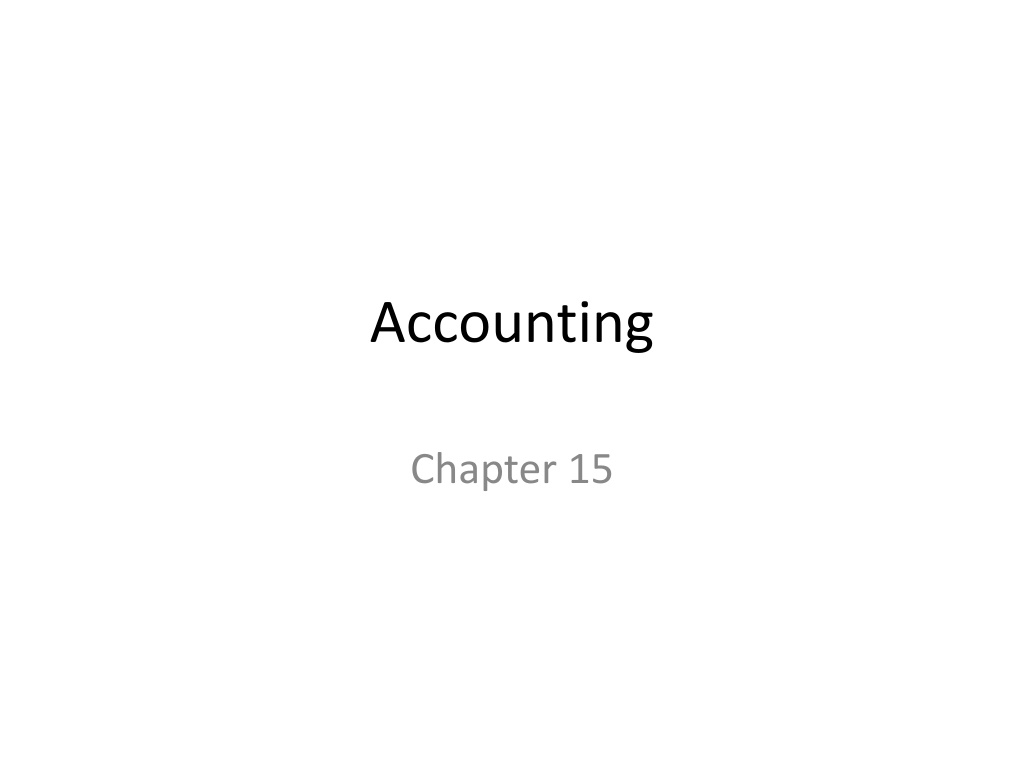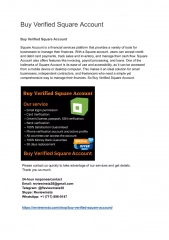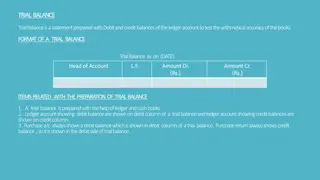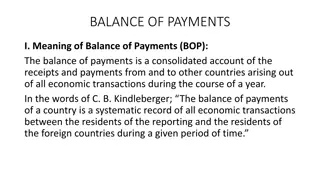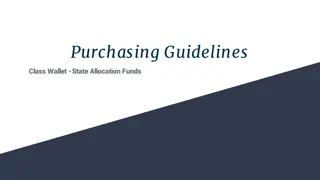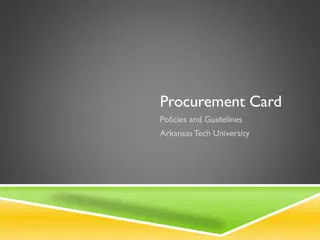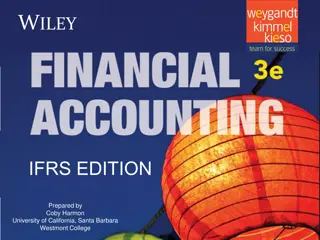Procedures for Processing Purchases on Account in Accounting
The process of purchasing items for a business involves several steps including requesting needed items, ordering from a supplier, verifying items received, and processing the supplier's invoice. A purchase requisition is prepared to request specific items, a purchase order is written to order from a supplier, items are checked upon arrival, and the supplier's invoice is compared against the packing slip before journal entry. The Purchases account is used to record merchandise bought for sale to customers.
Download Presentation

Please find below an Image/Link to download the presentation.
The content on the website is provided AS IS for your information and personal use only. It may not be sold, licensed, or shared on other websites without obtaining consent from the author. Download presentation by click this link. If you encounter any issues during the download, it is possible that the publisher has removed the file from their server.
E N D
Presentation Transcript
Accounting Chapter 15
Aim: Explain the procedures for processing a purchase on account. Do Now: Take out your notebook and copy the Aim. Take out Problem 15.1
Purchasing Items Needed by a Business The Purchasing Process Retail businesses need shopping bags, sales slips, and register receipts. They must also purchase other supplies, equipment, and merchandise. The purchase of the latter is divided into four stages: requesting needed items ordering from a supplier verifying items received processing the supplier s invoice
Requesting Needed Items When a company needs to buy supplies, equipment, or merchandise, a purchase requisition is prepared to request to order the specified items.
Ordering from a Supplier Information from the purchase requisition is used to write a purchase order. The purchase order contains: quantity description unit price total cost supplier s name and address date needed shipping method (optional) Problem 15.1
Verifying Items Received A supplier accepts a purchase order by shipping the items and billing the buyer for them. A shipment includes a packing slip that lists all shipped items. When a shipment arrives: The buyer unpacks and checks the contents against the packing slip. The buyer reports discrepancies to the accounting department.
Processing the Supplier s Invoice The supplier sends an invoice, or bill, to the buyer containing the terms and the item quantity, description, price, and total cost. The accounting department checks the invoice against the packing slip and purchase order. If there are no discrepancies, a processing stamp is placed on the invoice and the invoice becomes the source for a journal entry.
The Purchases Accounts Merchandise bought to sell to customers is recorded in the Purchases account, a temporary account that is classified as a cost of merchandise account. The Purchases account follows the rules of debit and credit for expense accounts. It is: increased by debits, decreased by credits, and has a normal debit balance. Purchases Debit Credit + -
Merchandise Business Project Day #1 As a group, complete your Business Plan. Hand in at the end of class.
Aim: Analyze transactions relating to the purchase of merchandise. Do Now: Take out your notebook and copy the Aim. Under the Aim answer: Why do you think a large business needs to maintain an accounts payable subsidiary ledger?
What Do You Think? Why do you think a large business needs to maintain an accounts payable subsidiary ledger? http://glencoe.com/sites/common_asset s/accounting/audit_alex/Player.html
Purchases of Assets on Account The most important thing a retail business purchases is merchandise to resell. Merchandise can be bought on a cash basis or on account.
The Accounts Payable Subsidiary Ledger A business that makes many purchases on credit will set up an accounts payable subsidiary ledger with an account for each creditor or supplier. The individual accounts are summarized in the Accounts Payable general ledger controlling account.
Merchandise Purchases on Account When a purchase of merchandise on account is recorded, a diagonal line is entered in the Posting Reference column to indicate the amount is posted in two places. First to the Accounts Payable controlling account. Then to the individual account in the accounts payable subsidiary ledger. The invoice is then placed in a tickler file (a folder for each day of the month) according to its due date. For example an invoice due on December 24 is placed in the 24 folder
Purchases Returns and Allowances A purchase return occurs when a business returns merchandise for a full credit. A purchase allowance occurs when a business keeps unsatisfactory merchandise but pays a discounted price. A debit memorandum is used to notify suppliers of a purchase return or request for purchases allowance. **Purchases Returns and Allowances is a contra cost of merchandise account.**
Recording a Purchases Returns and Allowances Transaction
Assignment Complete Problem 15.2 You have 5 minutes
Problem 15.2 Date Description Post Ref. Debit Credit 2017
Merchandise Business Project Day #2 As a group, work on #2 and #3 for your Merchandise Business. #2 Develop and Design the Store #3 - Acquire Merchandise ( from a wholesaler) #4 Retail Price List
Aim: How do I record the different types of cash payment transactions? Do Now: Take out your notebook and copy the Aim. Why do you think the accounting department is responsible for making cash payments for a business?
Controls over Cash A business can manage cash payments by following these procedures: Require proper authorization of all cash payments. Write checks for all payments. Use prenumbered checks. Retain and account for voided checks.
Recording Cash Purchases of Merchandise Usually businesses purchase merchandise on account. Sometimes a business buys merchandise for cash.
Prepaid Insurance Account Businesses purchase insurance to protect against losses from theft, fire, and flood. An insurance premium is paid at the beginning of the covered period and is recorded in the Prepaid Insurance asset account. Prepaid Insurance Debit Credit + -
Transportation In Account The shipping terms define if a buyer will be charged for the shipment of goods. Shipping terms are stated as: FOB destination the supplier pays the shipping cost FOB shipping point the buyer pays the shipping cost.
Recording Bankcard Fees (Expense Account) Banks charge a bankcard fee for handling bankcard sales slips.
Purchases Discounts The buyer may receive a purchases discount for early payment. If the credit terms listed on the invoice are 2/10, n/30, the buyer can receive a 2% discount if payment is made within 10 days, the discount period. If the invoice is not paid within 10 days, the buyer must pay the net amount within 30 days.
Purchases Discount **Contra Cost of Merchandise Account**
Homework Assignment Due Monday Complete Problems 15.4 & 15.5
Merchandise Business Project Day #3 As a group, work on your Merchandise Business. #2 Develop and Design the Store Mission statement, business description, etc. #3 - Acquire Merchandise (from a wholesaler) Research wholesalers online #4 Retail Price List #5 Sell Your Merchandise Write your transactions *Everything should be typed and printed out.*
